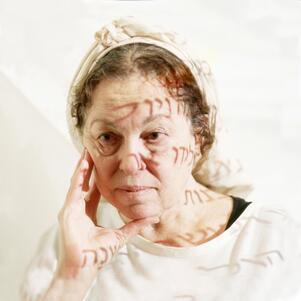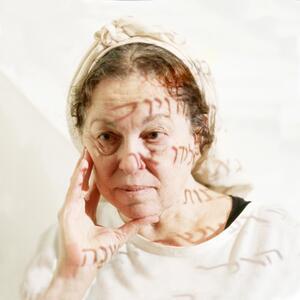Helène Aylon
I’m an eco-feminist artist. In the 1980s, I tried to “rescue” the earth by putting earth from military sites into hundreds of pillowcases. Then I drove the pillowcases of earth to the UN in what I called “The Earth Ambulance.” But it was also time to “rescue” G-d from the Patriarchy. So in 1990, I covered every page from the Five Books of Moses with transparent parchment, and, with a pink marker, I highlighted over words of misogyny and vengeance, cruelty and militarism, words attributed to G-d, and I highlighted between words where a female presence is omitted. Whenever I read that ubiquitous phrase, “And the Lord said unto Moses,” I looked long and hard because should we not be absolutely certain there is no misquote when someone (even Moses himself) quotes G-d? I called this action, “The Liberation of G-d.” I spelled the word God with a G, a dash, and a D as I was taught in my religious upbringing, but the dash is now pink… And I asked: When will G-d be rescued from ungodly projections in order to be G-d?
You see, I have come to believe The Five Books of Moses are indeed the Five Books of Moses, not the Five Books of G-d.
For this self-portrait, I stood in front of “The Digital Liberation of G-d,” a version of “The Liberation of G-d” using computer shading instead of a pink marker. I allowed the projected texts to cascade over my face – the same texts projected onto me in my Orthodox upbringing in Borough Park, in my schooling at the Shulamith School for Girls, in marriage to an Orthodox rabbi at age 18, in widowhood on my 30th birthday.
But the pull of nostalgia could not move my feminist stance.
Helène Aylon was an artist who addressed what she perceived as the three landscapes of feminism of the last three decades: biological, ecological, theological. Born, raised and schooled in the Orthodox tradition in Borough Park, Brooklyn, she married an Orthodox rabbi at age 18 and lived the life of a rabbi's wife until his untimely death the week of her 30th birthday. In the last years of the marriage, Aylon studied art at Brooklyn College with Ad Reinhardt, who encouraged her greatly. The mural, “Ruach,” that Aylon painted at Kennedy airport became the bridge between Aylon’s former life and the start of a search for a deeper spiritual ethic in the Torah. In 1973, Aylon moved to California to teach art at San Francisco State University and stayed for a decade. In the 1980s, she united Arabic and Jewish women in “A Stone Carrying." In 1982, she drove an "Earth Ambulance" cross-country as a participatory performance, stopping at military sites to gather earth into pillowcases donated by hundreds of women. The ambulance and pillowcases are a permanent installation at the Hudson Valley Center for Contemporary Art in Peekskill, NY. From the 1990s on, she explored the omission of women in the Jewish tradition and the projection of patriarchal values onto G-d. “The Liberation of G-d” is a permanent acquisition at The Jewish Museum in New York, and the “Digital Liberation of G-d” is a permanent exhibit in the San Francisco JCC. She died on April 6, 2020, from complications of the COVID-19 virus.
More on Helène Aylon
- Lesson Plan: Wrestling with God and Jewish Tradition
- This Week in History: Opening of "Too Jewish?" exhibit featuring work of artist Helène Aylon
- Blog: Happy Earth Day! … with a Jewish, liberationist twist
- Blog: Helène Aylon: Artist, Ecofeminist, Author
- Blog: Artists For A Cause






Helene was a remarkable woman and artist. She created a remarkable journey in her life. I am so happy to have been her friend.